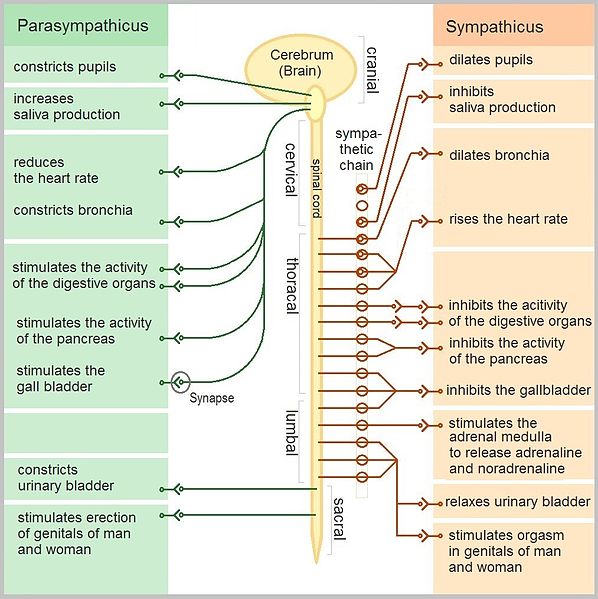Dalia Savy
AP Psychology 🧠
334 resourcesSee Units
Multiple Choice Practice for Biological Bases of Behavior
Welcome to Unit 2 AP Psychology Multiple Choice Questions! Grab some paper and a pencil 📄 to record your answers as you go. You can see how you did on the Unit 2 Practice Questions Answers and Review sheet once you're done. Don't worry, we have tons of resources available if you get stumped 😕 on a question. And if solo study is not your thing, join a group in Hours!
Not ready to take a quiz yet? Start studying unit 2 here: Intro to Unit 2

Image Courtesy of Wikimedia Commons.
Here is a quick overview of the functions of the parasympathetic and sympathetic nervous systems throughout the body.
Facts about the test: The AP Psychology exam has 100 multiple choice questions and you will be given 1 hour and 10 minutes to complete the section. That means it should take you around 11 minutes to complete 15 questions.
*The following questions were not written by CollegeBoard and although they cover information outlined in the AP Psychology Course and Exam Description, the formatting on the exam may be different.
1. Mariel was in a car accident and suffered damage to her reticular formation. Which of the following is she most likely experiencing?
A. Convulsive Seizures
B. A Coma
C. Inability to Make New Memories
D. Change in her Personality
2. After suffering a stroke, Manny lost his ability to comprehend language. It is most likely that Manny suffered damage to
A. His right temporal lobe
B. His hippocampus
C. Wernicke’s Area
D. Broca’s Area
3. The somatosensory cortex is to the ______ lobe as the motor cortex is to the ______ lobe.
A. Parietal; frontal
B. Occipital; frontal
C. Frontal; temporal
D. Parietal; temporal
4. Polarization is to ______ as depolarization is to ______.
A. Action potential; resting potential
B. Resting potential; refractory period
C. Resting potential; action potential
D. Action potential; refractory period
5. Juan was bit by a black widow spider. The venom is an agonist for Ach. What is Juan likely to be experiencing?
A. Paralysis
B. Migraine Headaches
C. Insomnia
D. Muscle spasms
6. Night terrors are to ______ as hypnagogic sensation are to ______.
A. Stage 3; Stage 1
B. REM sleep; REM sleep
C. REM Sleep; NREM sleep
D. Stage 4; Stage 2
7. What is the role of the suprachiasmatic nucleus?
A. It increases the production of dopamine, causing us to feel pleasure
B. It blocks messages between our motor cortex and brainstem, causing paradoxical sleep
C. It suppresses the pineal gland's production of melatonin, causing us to awaken
D. It interferes with our natural circadian rhythms, causing insomnia
8. Aiko has been struggling with depression and finds it difficult to concentrate on her school work. It is most likely that Aiko has a shortage of which neurotransmitter?
A. GABA
B. Dopamine
C. ACh
D. Serotonin
9. Neurotransmitters receptor sites are located on the
A. Soma
B. Dendrites
C. Axon
D. Terminal Branches
10. Your ability to swat at a fly buzzing around your head is due to your
A. Somatic nervous system
B. Autonomic nervous system
C. Parasympathetic nervous system
D. Endocrine system
11. The "uncommitted" areas of the cerebral cortex that are involved in higher-order cognitive functions and are more pervasive in more intelligent animals are called
A. Hemisphere lobes
B. Cortex interfaces
C. Association areas
D. Wernicke’s area
12. The part of the brain that links the nervous and endocrine systems is the
A. Pituitary Gland
B. Thalamus
C. Hypothalamus
D. Hormones
13. What can be expected in someone who has been a long-term user of the drug Ecstasy?
A. An increased production of dopamine, resulting in hallucinations
B. Damaged serotonin-producing neurons, leading to depression
C. Reduced dopamine levels, resulting in depression
D. Decreased production of endorphins, leading to lower pain thresholds
14. Which of the following technologies would be most useful for determining what stage of sleep someone is in?
A. MRI
B. fMRI
C. PET Scan
D. EEG
15. If a trait is found to be 85% heritable, what does that mean?
A. It means that you are highly likely to inherit that trait if it is passed down to you by your parents
B. It means that 85% of that trait comes from your genes and 15% from your experiences
C. It means that 85% of the variation of that trait among individuals in a group can be attributed to genes
D. It means that 85% of that trait can be attributed to your experiences and 15% to your genes
Time to Check Your Answers on Unit 2 Practice Questions Answers and Review! 🙌
Browse Study Guides By Unit
🔎Unit 1 – Scientific Foundations of Psychology
🧠Unit 2 – Biological Basis of Behavior
👀Unit 3 – Sensation & Perception
📚Unit 4 – Learning
🤔Unit 5 – Cognitive Psychology
👶🏽Unit 6 – Developmental Psychology
🤪Unit 7 – Motivation, Emotion, & Personality
🛋Unit 8 – Clinical Psychology
👫Unit 9 – Social Psychology
✏️Frequently Asked Questions
🧐Multiple Choice Questions (MCQ)
✍️Free Response Questions (FRQ)
📆Big Reviews: Finals & Exam Prep

Fiveable
Resources
© 2023 Fiveable Inc. All rights reserved.